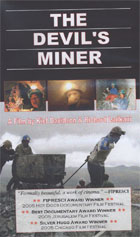
The Devil’s Miner 2005
Distributed by First Run/Icarus Films, 32 Court St., 21st Floor, Brooklyn, NY 11201; 800-876-1710
Produced by Kief Davidson and Richard Ladkani
Directed by Kief Davidson and Richard Ladkani
VHS, color, 82 min.
Sr. High - Adult
South American Studies, Sociology, Human Rights
Date Entered: 06/12/2006
ALA Notable: ALA.gif
Reviewed by Veronica Maher, Roger Williams University, Bristol, Rhode Island
Cerro Rico, “the rich mountain” has been mined for silver ore since the sixteenth century. The city of Potosi once the largest city in the world lies below this Bolivian mountain. Today the over 5000 miners still search for silver and other minerals deep beneath the surface. The mining is hard work and the miners expose themselves to the dust that leads to their premature death from the lung condition silicosis. The average life of a miner is around forty years. Despite this predictable outcome the miners continue to risk all for their families. There is little else for many of them.
The two boys featured in this video were not born to mining but because they lost their father at an early age they are working to help support the family. The film takes us through a season of their life at ages fourteen and twelve. The film profiles Basilio and Bernardino Vargas who have dreams of getting an education and leaving the mountain for a better life. Will they accomplish this goal? Certainly not without help.
What is obvious to the viewer is the deep attachment they all have for each other and their determination to succeed. What is also obvious is that there are no apparent social programs available to help either the boys or the ailing miners. Who owns these mines? How is it that such poverty is left unabated? Where is the government? Does the Church care not about the conditions of poverty but just the devil worshipping? The miners worship the cave god Tio and with their offerings count on him to protect their lives.
The story does reveal “an incredible sadness” in beautifully filmed realism but it is too long and often repetitive. The film is in Spanish with English subtitles. One cannot watch this film and not wonder what will happen to these boys and wonder about the alleged 800 children still working in the tunnels of Cerro Rico. The winner of numerous awards the film is compelling and will certainly bring awareness of yet another third world travesty.
A visit to The Devil's Miner web site reveals that over one million Euros have been donated for the children of Potosi as a result of this film. PBS has aired the film as part of their Independent Lens series, and a two-minute trailer is available on their web site.
Awards
- Best Documentary, Woodstock Film Festival;
- Humanitarian Award Mexico City Film Festival
- Emerging Filmmaker Award, Tribeca Film Festival
- Best Documentary, Silver Hugo, Chicago Film Festival
- Best Documentary, Woodstock Film Festival
- Best Documentary, Spirit of Freedom Award, Jerusalem Film Festival
- Fepresci Prize, International Film Critics Award, Hot Docs, Toronto